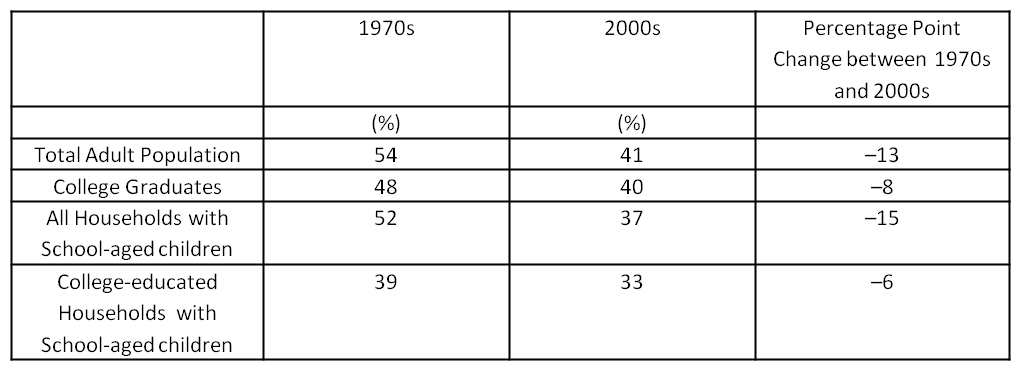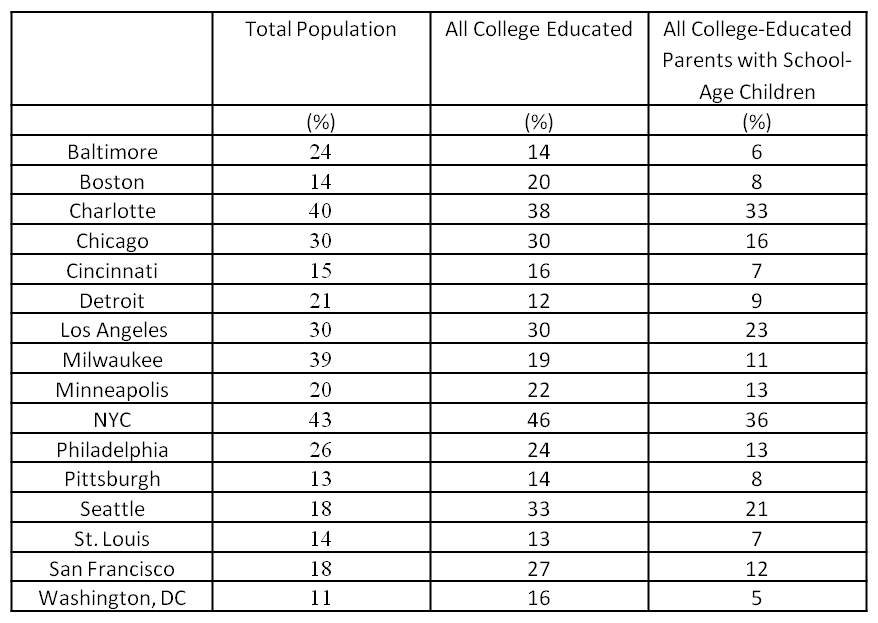Families and Central Citites
For central city economies like those of New York and Chicago, the 1970s were a low point as middle- and upper-income households in large numbers suburbanized out of older cities of the Northeast and Midwest. Since then, some central cities have been rediscovered, especially by younger and educated singles. Moreover, to a lesser extent, central cities have also been rediscovered by older (often retired) households with middle and upper incomes. Prominent researchers, such as Ed Glaeser, have described this return to central cities, along with the particular features of urban areas that have attracted households back. Some of the attractiveness of central cities has been attributed to such amenities as high culture venues, falling crime rates, lively night life, older architecture, and an active “marriage market.” Others note that highly skilled and educated workers have also found superior employment opportunities in central cities, and so, their decisions to reside in urban areas have often been affected by their locations of work.
But how have central cities (relative to suburbs) fared in attracting and keeping families with children? Since the 1970s and 1980s, many cities have been criticized for their poor quality of public schools, and in turn, many city officials have pledged to reform and improve cities’ educational offerings. Additionally, unsafe or crime-prone neighborhoods have been sometimes associated with central cities, although crime rates have generally been falling over time.1 Lower-income children attending poor-quality schools and living in unsafe neighborhoods are perhaps most at risk, since their families may often be hard-pressed to provide them with the attention and resources necessary to build up their human capital and keep them safe.
That said, more telling insights on the city versus suburb location decision may be gleaned by examining households that have high educational attainment and high income. Such households are usually the ones that are most mobile and most able to choose—that is, they are the families who can “vote with their feet” and who aren’t constrained by a lack of household income, challenges in gaining access to information on outlying neighborhoods, and limited housing/neighborhood opportunities.2
It is further evident that households with high education and high income tend to choose communities based on criteria such as the quality of local schools, safety, and the education level of residents.3
For these reasons, residential choices of households with high levels of education and income may be an important bellwether for many families in identifying their preferred residential locations. So, too, the attraction and retention of such high educations households in central cities may be a keen public policy target. To repel highly educated, highly paid workers from living in central cities would impose real costs—indeed, without a pool of such workers readily available, cities might have greater challenges in attracting more businesses and jobs, as well as building up a strong commercial tax base.
Preliminary evidence suggests that, on average, cities have shown limited progress in becoming more amenable places in which to live for families with children. The table below, drawn from the National Opinion Research Center’s General Social Survey, indicates that since the 1970s, suburbs have maintained their edge over cities as the preferred locale of residence for families with children. For the 100 largest metropolitan statistical areas (MSAs) surveyed, the share of the total adult population living in central cities has declined in tandem with the share of those adults having children. Similarly, the share of the overall college-educated population residing in central cities has also declined in tandem with the share of such college-educated adults having children.
However, the General Social Survey data do suggest that college-educated adults have tended to suburbanize at a much lower rate than the overall population. Likewise, college-educated adults with children have also tended to move to the suburbs at a lower rate relative to the overall population with children.
1. Percentage of 25+ year olds living in central cities of 100 largest MSAs, 1970s and 2000s

The table below offers a demographic snapshot of 16 large metropolitan statistical areas, with a focus on the population share living in the central city. The first column itemizes the shares of the MSAs’ total populations that live within central city boundaries. This column offers an important point of comparison among MSAs because city versus suburban land share (and population share) can vary widely across MSAs. Such differences stem from the fact that in many instances, city boundaries have been cut short historically because cities failed to annex population growth on their urban fringe.
The second column provides population shares of college-educated adults aged 25 years and older living in central city limits. Some cities, such as Boston, Minneapolis–St. Paul, San Francisco, and Washington, DC, rank highly as the chosen locations of residence for college-educated adults; indeed, this is indicated by their shares of living within central city boundaries being higher than that of the general population.
In the third column, cities are generally shown to be the domicile of far fewer college-educated parents with school-age children (relative what is seen for the total population and for the overall college-educated population). On average, these 16 central cities are home to 24% of their MSA populations, but only 14%% of their college-educated parents with school-age children. Even for cities with a relatively high share of all college-educated adults residing within them, college-educated parents with school-age children will tend not to follow their counterparts without children. For example, 16% of the college-educated adults in the Washington, DC, metropolitan area live within the District, yet only 5% of the college-educated parents of school-age children do. There are some exceptions: Central Charlotte and New York tend to retain a share of such college-educated parents in their respective MSAs roughly in proportion to college graduates who are not parents.
2. Percentage living within central city boundaries of the Metropolitan Area 2009

What explains these differences across metropolitan areas? As always, there are many crosscurrents to understand and account for. For instance, some cities may be more successful than others at hosting employers with job opportunities for highly skilled and educated workers, who, in turn, choose to live in proximity to their job sites. Additionally, some cities may attract highly educated (but childless) persons because of their amenities such as excellent night life and architectural preservation. Such features may not be very high priorities for parents (regardless of educational background) with school-age children. However, differences in schools and safety may matter greatly to families with children. Indeed, many complex factors go into the decisions of different demographic groups choosing to live in and out of central cities. Accordingly, over the coming year, Bill Sander and I will be further analyzing data while accounting for all of these considerations.
Footnotes
1 Crime rates in cities and in suburbs have fallen markedly (on average) since the 1990s, with city crime rates tending to fall more steeply but with suburban communities maintaining lower (average) rates of crime over a longer period. See Ingrid Gould Ellen & Katherine O’Regan and Elizabeth Kneebone and Steven Rafael.
2 For data on the frequency of moves by demographic characteristics, see, U.S. Census Bureau, Geographical Mobility: 2010 to 2011. Households with higher educational attainment move more frequently for long distance moves. For local moves, this is not the case.
3 See, for example, Julie Berry Cullen and Steven D. Levitt, 1999, “Crime, Urban Flight, and the Consequences for Cities,” Review of Economics and Statistics, Vol. 81, No. 2, May, pp. 159–169; this article shows that households with high human capital demand a safe environment, which make many suburban areas more attractive to such households. Additionally, see David Albouy and Bert Lue, 2011, “Driving to opportunity: Local wages, commuting, and sub-metropolitan quality of life,” University of Michigan, working paper, August 8, 2011; this paper shows that households pay premia to live in those suburban areas and city neighborhoods having low crime and well-funded schools.








